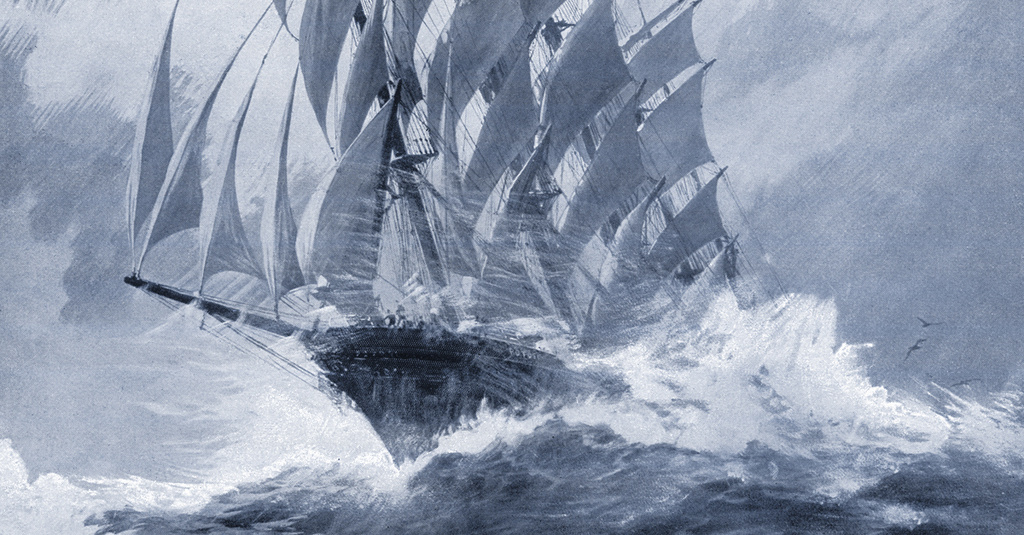
Clipper Ships
The clipper ships were the fastest sea vessels of their time, symbolizing American exuberance and ambition in a time when we prioritized achievement over profit. We see this “clipper ship mentality” in later innovations, and we desperately need this audacious spirit today.

- R. J. Rushdoony
Chalcedon Report No. 276, July 1988
It was in 1932 that I first read John Gould Fletcher’s beautiful poem, in polyphonic prose, “Clipper Ships,” now forgotten by most because Fletcher was too emphatically and happily American to suit our day. Fletcher, in “Clipper Ships,” celebrated the exuberant and triumphant days of the clipper ships, perhaps the most amazing sea vessels ever to sail the seas. Frederick Jackson Turner, an historian often criticized today, was accurate in catching the “optimistic and creative” temper of America then, dealing with things “in an original, practical, and determined way and on a grand scale.”
John Lofton recently gave me a lovely booklet on clipper ships, Heralds of Their Age (1972), designed by Emma Landau and edited by Peter Stanford. In the preface, Robert G. Albion noted, “The Clipper ship was the supreme expression of the emotional enthusiasm that swept over the American maritime world in mid-nineteenth century.” Americans believed they could, Stanford notes, “go anywhere, do anything, be anything.”
The clipper ships were expensive and less profitable than the “square riggers on schedule,” but they had an amazing speed and a breathtaking beauty. Earlier ships bore the names of women, often the owner’s or captain’s wife: Mary Ann, Adelaine, and so on; now ships have very prosaic and dull names. The clipper ships were given exciting names: Lightning, Sovereign of the Seas, Challenge, Flying Cloud, Stag Hound, Glad Tidings, Invincible, Defiance, Great Republic, Intrepid, Flying Arrow, Hotspur, Romance of the Seas, Sparkling Wave, Dashing Wave, Ocean Spray, Skylark, Golden Eagle, Gazelle, and so on and on. They left other ships in their wake, and, from the sail, would come a proud cry to the passed ship, as reproduced by Fletcher: “Challenge is our name: America our nation: Bully Waterman our master: We can beat Creation.”
After a glorious decade, 1847–1857, the clipper ships began to go; before long, the ironclad ships replaced them. They represented in their day the temper of a segment of American free enterprise, confident, exuberant, and placing achievement and glory ahead of profits. Some of the clipper-ship captains pushed sails, timber, and men to their limits to demonstrate what Americans could do. The clipper-ship men, like Donald McKay, were the American frontiersmen of the seas. Other men took their places, small and mean-spirited men.
Yet, in the 1930s, Pan American briefly caught the American eye with their trans-Pacific planes, called “Clipper Ships.” In the next decade, a group of men created Raytheon and brought remarkable inventions into the market. Some years later, a number of young men started the computer industry. The clipper-ship men were not all gone, but both political parties and Washington, D.C., Congress especially, were closer to the slave ships in spirit than anything else.
The clipper-ship mentality had not been confined to the seas. In 1780, America had three million people, of whom 900,000 were Scots and 400,000 were English. We began as a Scottish country, and a British agent called the War of Independence, “a Scottish-Irish-Presbyterian rebellion.” A Basque saying in the American West has it that, when the Armenians came to America, the first thing they did was to build a church, while the Basques built a hotel (to eat and have fellowship therein). We can add that the Scots built colleges everywhere, in the newly settled wilderness, with a conquering hope for the future. We are very much in need again of clipper-ship men and their exuberant confidence in victory.
Last night I dreamt happily of the magnificence of the clipper ships in the high seas and their triumphant passage forward. I woke up with this sentence in mind: “A saved man is God’s clipper ship in history.”
The storm clouds are very real and dark, but, like clipper ships, we shall ride through them.

- R. J. Rushdoony
Rev. R.J. Rushdoony (1916–2001), was a leading theologian, church/state expert, and author of numerous works on the application of Biblical law to society. He started the Chalcedon Foundation in 1965. His Institutes of Biblical Law (1973) began the contemporary theonomy movement which posits the validity of Biblical law as God’s standard of obedience for all. He therefore saw God’s law as the basis of the modern Christian response to the cultural decline, one he attributed to the church’s false view of God’s law being opposed to His grace. This broad Christian response he described as “Christian Reconstruction.” He is credited with igniting the modern Christian school and homeschooling movements in the mid to late 20th century. He also traveled extensively lecturing and serving as an expert witness in numerous court cases regarding religious liberty. Many ministry and educational efforts that continue today, took their philosophical and Biblical roots from his lectures and books.